10 March 2024
A Guide to Spending in Italy: Currency Options & More
A Few Helpful Tips as You Prepare to Visit Europe & Italy
While preparing to visit Italy, and for that matter anywhere across Europe, a common question many Americans have has to do with money.
Or more specifically, currency, and how (and when, where) they can exchange some of their cash for another kind–like Euros. It’s related to what I think is a common fear, especially among those leaving the U.S. for the 1st time: being caught in the unenviable position of being in a foreign place without a way to pay for anything. It sounds like a scenario recreated in the opening scenes of a horror flick, lets be honest.
And although the adoption of the Euro has made travel across the various countries of Europe infinitely easier, when it comes to money there is no shortage of caveats, unique situations and cautious tales. Whether a first timer or a veteran of traveling abroad, there are several important things that Americans should know before their next trip across the Atlantic.
While I don’t have a “new American girl in Italy” nightmare to share–or one that wouldn’t bore you to death, at least–I certainly have learned a few things since moving here. And I’ve definitely picked up a few tricks & tips these past couple years.
Let’s get to it, shall we?
This blog is broken down into three simple sections:
1) A guide to what currencies (and credit cards) are accepted throughout Italy & Europe
2) A review of how to best utilize exchange rates and where/when/how to make a currency exchange
and, of course…
3) Several tips & tricks, anecdotes, and nuggets of information covering everything “money”— from why you should avoid spending US Dollars even in places that advertise their acceptance, to why Travelers Checks that generations of people grew up with are no longer necessary…and actually can be more inconvenience than not.
So let’s get to it.
But before that…I leave you with a clip from an underrated comedy treasure.
Spending Money in Italy & Europe
Peaking inside your wallet to see what will be accepted, and what won’t be
- Cash is King in Italy! Italy is pretty well known to be a cash-based society, even in comparison to close European neighbors. The biggest reason for this is that Italy is dominated by small villages and towns, and many of the most tourist-friendly places have economies built around independently owned shops, eateries, street vendors and more.
Like the rest of the modern world, the usage & acceptance of Credit & Debit Cards and “Alternative” Payment Apps is increasing rapidly. While many places might accept your card, just be prepared–have cash on you, or a way to get cash, at all times. - Credit Cards: Visa and Mastercard are the big two. If a place/store takes credit card payments it is virtually guaranteed these two are accepted.
American Express and Discover, however, are a different story. Discover, in fact, wasn’t accepted anywhere in Italy as recently as a decade ago. Major hotel chains and such, especially in cities like Rome, might take it, but it’s not a given. And it’s incredibly rare you will find many places in smaller resort towns and the various vineyards.
It’s similar with American Express, but not quite as drastic. If you broke it down by percent, of the places that accept card transactions, 99.6% (or more) take Visa/MC, between 45% and 55% accept AMEX, and 10-15% Discover. And for the few people that still have Diner’s Club cards…I swear, someone asked me that recently… those are now owned and operated under Discover (and only work through Discover card systems). - You can forget about most of the American payment “apps”, things like CashApp, Venmo, etc. PayPal has 91% of the market share in Italy as far as “online” banking/payments, but it is almost exclusively used for peer-to-peer payments. It’s just incredibly rare to find businesses that accept these types of things. Further than that, CashApp, for example, won’t even work for you in Italy (there’s reasons why you have to “share” your location when you download!)
- One result of COVID-19 was the rapid growth of contactless payment, and the number of places that accept it. In major tourist hotspots like Rome and Milan a good number of places now have the capability, which also means that things like GooglePay and ApplePay are often accepted (provided they’re being funded via Visa/Mastercard, of course)
- While some tour companies will accept US dollars in some cases, it’s very rare, and you shouldn’t assume you can use US dollars anywhere in Italy. Like much of Europe, Italy uses the Euro, represented with the € sign. Paper currency comes in denominations of 5, 10, 20, 50 and 100€. Similar to the dollar, fractions of a Euro are called cents. Coins can be found in in 0.01, 0.02, 0.05, 0.10, 0.20 and 0.50 cent denominations, along with 1€ and 2€. And in contrast to the US$, 1€ and 2€ denominations are in Coin only
The “Common” side of Euro Coins–
Regardless of issuing country this side is always the same








A few examples of Euro Coins issued in Italy
(Pictured: 1 Cent, 2 Cent, 1 and 2 Euro)
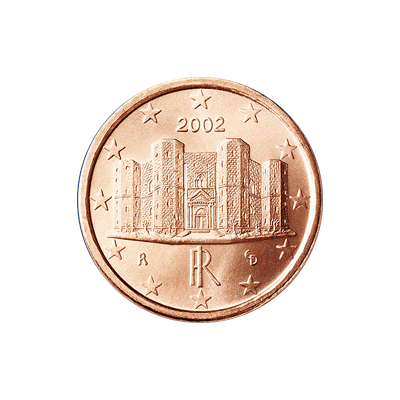
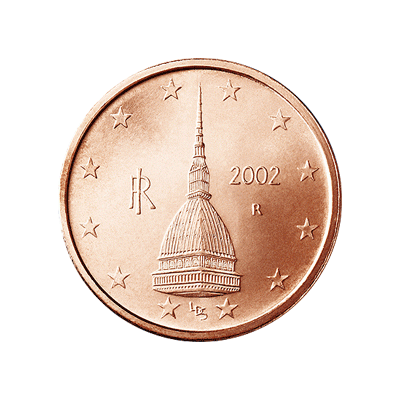
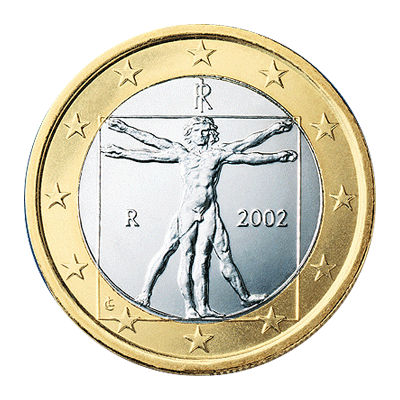
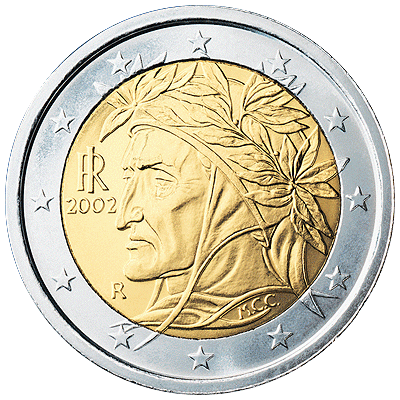
Examples of paper/bill Euro Denominations
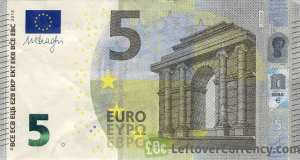
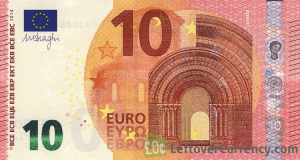
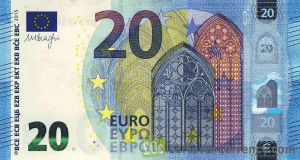
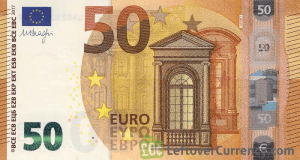
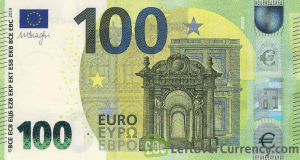
Exchanging Your Dollars and
Having It Make Sense
Avoid Wasting Money with These Tips
Exchanging your US Dollars for foreign currency is simple in theory, but like everything else in life, in actuality gets complicated real quick.
There’s a reason why you see “Exchange Currency Here” signs seemingly everywhere when you get off a plane, train, ship…hell, you can do somersaults and back-flips across a sovereign border and you’re pretty much guaranteed to land within a few feet of one. And that’s because it’s “easy money” for the one doing the exchanging. Places in high traffic tourist spots can take upwards of 10%(+) just for swapping one form of money for another.
So keep these things in mind when it comes to Exchange Rates and Spending Money in Italy:
- The current exchange rate between US Dollars and Euros depends slightly on which direction ($ to €, € to $) the exchange goes. You can expect $1 to get you roughly .92-.93 cents in Euro. Conversely 1€ gets you between $1.08 and $1.09.
- You should try your best to avoid the instinct to exchange currency right upon entering Italy/Europe, places like airports and train stations. Similar to how a bottle of water magically goes from a dollar at 7-11 to like 6 bucks at the airport, you’ll end up paying higher fees or commissions on any exchange, regardless of how they advertise their exchange rate. Transportation & tourist hubs charge those prices because, well, they can. And they don’t suddenly become altruistic when it comes to turning your $1 Bill into a 1€ Coin. Trust me.
So how should you exchange / get Euro for your trip?
1). At Your Bank: The first and best place to exchange your money is right at your bank in your home country. This is where you’ll get the best exchange rate most of the time! Bigger banks in the US will likely have Euro on hand and can do the transaction immediately, however smaller banks and branches may have to order it. Your best bet (better safe than sorry!), is to go to. your bank and exchange money 2-4 weeks before your trip.
2) Small shops and cambios, which are kinda like small boutique shops for these types of services. Be aware that “tourist traps” like the transportation hubs still may apply, so this refers to more within villages and towns than meccas. I cover the way to approach this a bit more in the final section.
3) An Italian ATM: The fastest and easiest way to get Euro is to simply use your debit card at an ATM when you’ve arrived in Italy. But not any ATM, because there’s naturally a caveat for that too!
- You want to make sure the ATM is bank-affiliated (bancomat). Bancomats affiliated with one of the main banks in Italy do not charge fees. You will get the established government exchange rate without a commission fee, assuming you are using the ATM to withdrawal funds from your US checking account. You absolutely should avoid independent ATMs, the most popular being EURONET. You know the type…the little ones you see in corners of random liquor stores and such. The fees from independent ATMs can be simply disgusting.
- One thing you don’t want to use an ATM for is withdrawing cash off a credit card. This isn’t across the board, as their are a number of credit cards tailored to international travelers, but generally speaking credit card companies do one thing well: make money, usually with unproportionate fees–like ones for cash advances.
- You want to make sure the ATM is bank-affiliated (bancomat). Bancomats affiliated with one of the main banks in Italy do not charge fees. You will get the established government exchange rate without a commission fee, assuming you are using the ATM to withdrawal funds from your US checking account. You absolutely should avoid independent ATMs, the most popular being EURONET. You know the type…the little ones you see in corners of random liquor stores and such. The fees from independent ATMs can be simply disgusting.
Be Sure to Check Out My Customized Amazon Recommendations! Personally Selected Items to Help Keep Your IDs, Passports, Travel Documents & More Safe During Your Travels!
You can also check out all the rest of my Amazon recommendations!
Before You Go…
A Few More Things to Know
Some Last Pearls of Wisdom, Nuggets of Gold and I’ve run out of Money Puns
- A good website for up to the minute exchange rate info, for any and all recognized legal tender, can be found here. Your local bank branch often provides printed rates upon request, as well, for a good idea of what to expect before you arrive.
- Before leaving on any trip, be sure to contact your bank/debit card and credit card companies. Many banks put automatic fraud safeguards in place and you can be easily caught unaware until your card is declined. Chase Bank, for example, often denies ATM withdrawals over $25 if not done within a certain proximity to your billing/account zip code. The additional layers of protection are generally great for account holders and consumers, of course…until they’re not.
- While on the phone with the credit card peeps, ask for details on/if they have any sort of travel insurance/protection. A large number do, though you can expect a whole lot of fine print along the way. Whether its Rewards Points for airline travel, rebates for hotel chain bookings or custom travel insurance packages, you’d be surprised what you can learn from these calls.
- Once in Europe…Keep a set amount of euro on you. As I mentioned, because of the predominance of small markets & shops, and the overall cash-dominant economy of Italy, it’s always smart to make sure you have local currency on you in case of unique circumstances or emergencies. But be sure to exchange them back to US Dollars before heading home! Especially the coins–you’ll be amazed how quickly change can accrue in your pocket when you’re dealing with a couple extra fractions of denominations, along with the lack of a 1 or 2 Euro bill.
Obvious Note: In the States it can be easy to just toss change aside or let it be buried within the couch cushions. It’s a bit different when you pay for a 0.70 cent candy bar with a 5€ bill and get your change all in coins! - I know some of the older generations will revolt at the mere thought, but Traveler’s Checks … are no longer a viable way to protect your money abroad. Most of Europe, especially Italy, it’s downright extremely rare to find a place that actually accepts them for purchases. Even most of Italy’s official banks will not cash them. And even you do find a place that will honor the check, or swap it for euro, you can expect grossly exorbitant fees for their trouble.
- Like many modern countries, you will find a lot of shops that accept US currency. It can be tempting, too, because its comfortable. It’s not advisable, however. “Rounding off” might not be a “fee”, but it’s not rounding for your benefit obviously. Small shops and eateries might charge you as much as 20% more if you pay with US Dollar, quite a bit more than the actual 7-8.5% difference in currency value.
- It sounds simple and obvious, but you’d be surprised. Leave the weight at home! All those random store credit cards and pharmacy/grocery store rewards cards. Stick with one or two credit cards, your bank card and cash money. That’s it. Traveling, vacationing, especially with a family and kids, can be a smorgasbord of spending, of nickle and dimes. Keeping track can be a nightmare, even more so when dealing with foreign currency. Its easier to keep up with your budget, too. And honestly, the majority of everything else won’t be used or can’t be, and serves only as opportunity for those with ill intent like scammers and thieves.
- Be wary of Dynamic Currency Conversion (DCC), or Cardholder Preferred Currency (CPC). These are merchant-provided services that let you see your foreign credit card transactions in your home currency at the point of sale. Fees for DCC are higher than those charged on regular credit card transaction. DCC is optional; do not let a store force you to do this if you dont want to. It’s akin to the “rounding off” and “currency surcharges” that the shops do with US Dollar payments.
From the website Investopedia:
“Dynamic currency conversion (DCC) allows you to make point-of-sale (POS) credit card purchases in a foreign country using the currency of your home country; it is also known as cardholder preferred currency (CPC). While DCC makes it easier to understand the price you are paying—and lets you avoid doing the currency conversion math—it often comes with a poor exchange rate and other fees that can make the transaction more expensive than if you simply made it in local currency.” -jim brobasco on investopedia
That’s your guide to “Spending in Italy”!
Hopefully it will answer some questions and give you some guidance if–sorry, when–you begin planning your trip abroad.
Check back periodically as this blog, like the previous ones covering Travel & Entry Requirements and What You Can Bring Home Through US Customs, will be updated regularly with updated information and fresh tips.
Please Note: As an Amazon Influencer, I earn from qualified purchases.












